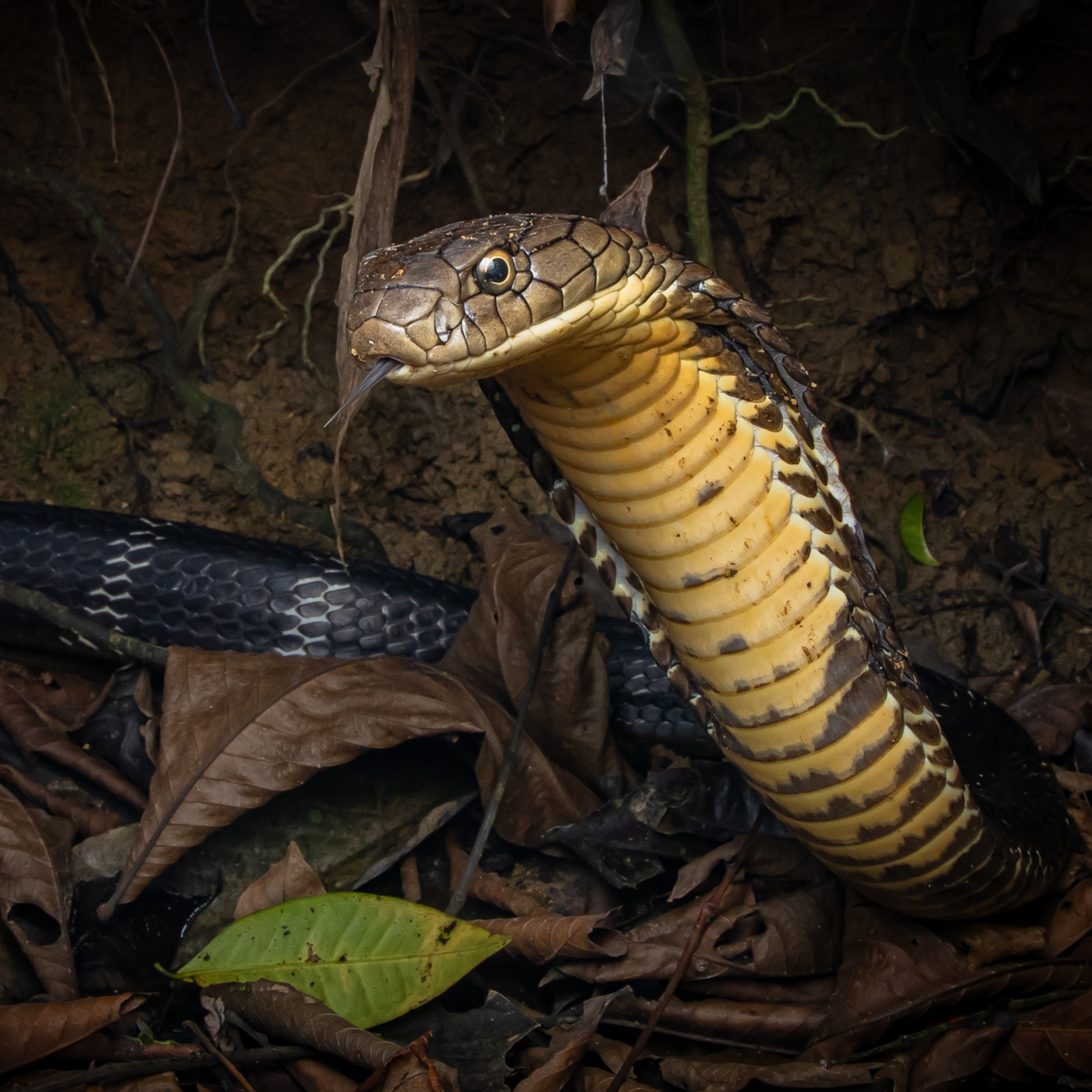
The king cobra is likely a ‘royal family’ of four species
The discovery could lead to a more effective antivenom to treat snakebites throughout East and South Asia.
Herpetologists have long wondered how the king cobra, which slithers across massive Asian landscapes separated by seemingly impenetrable divides such as the Himalaya could be a single species. It also puzzled them that the world’s longest venomous snake, which can reach 18 feet, often has a different appearance or behavior depending on where it lives.
Now, it all makes sense: The king cobra is in fact a “royal family” of four separate species, new research suggests.
Last August, P. Gowri Shankar, a biologist and king cobra expert at the Kālinga Foundation, a conservation nonprofit in Shivamogga, India, and his colleagues reported four genetically unique lineages of king cobra. They identified them by region: Western Ghats (southwestern India), Indo-Chinese (eastern India and China), Indo-Malayan (Indonesia and Malaysia), and Luzon Island (Philippines). The snakes’ scientific names have yet to be approved by the International Commission on Zoological Nomenclature.
Years of intrepid serpent trapping in tropical rainforests, combined with new technology that can analyze badly degraded museum specimens, finally yielded enough DNA for the scientists to properly identify the additional species.
“If it’s a frog, if it’s turtle, it would have been easier,” Shankar says of their work. “The king cobra is a different story.”
When disturbed, a king cobra can rear up to eye level and deliver enough venom to kill an elephant. Shankar says he’s one of few people to have survived a king cobra bite, a fortune he attributes to the small amount of venom the snake injected. The experience also motivated him to find a more targeted treatment for king cobra bites.
(Cobras Spit Venom at Eyes With Nearly Perfect Aim)
Indeed, that cobras are different enough to be four distinct species could have major real-world ramifications, he says—particularly the possibility of producing a more effective antivenom that could specifically target these species’ individual venoms. (Read how harnessing the power of venom could lead to new medicines.)

What’s more, Shankar adds, identification of the new species could boost conservation efforts for the snakes, which are declining across their range because of deforestation and urbanization. The International Union for the Conservation of Nature (IUCN) lists the king cobra as vulnerable to extinction.
In light of the findings, the IUCN plans to reassess the king cobra’s conservation status, says Philip Bowles, coordinator of the organization’s Snake and Lizard Red List Authority, which surveys reptiles in the wild worldwide and determines their conservation status.
A snake of a different color
“Having looked at [king cobras] closely for more than 50 years, you could see that they are … different,” says Romulus Whitaker, a longtime snake expert and founder of India’s Chennai Snake Park, a nonprofit that educates the public about snakes.
“We just needed someone to do the hard work to prove it," he says. (Read about the unconventional life of India's "Snake Man.")
For instance, scientists have wondered why adult king cobras in Thailand and neighboring countries have more than 70 off-white bands encircling their bodies, while those in the Philippines have only a few that are barely discernible.
There are variations in nesting behaviors too. The female king cobra is the only snake that builds nests for her eggs—no small feat for a limbless creature. She uses her body to shimmy twigs and leaves into place. (Go inside the world’s largest gathering of snakes.)
Females in the Western Ghats abandon their eggs soon after making their nest, whereas Indo-Chinese mothers guard the eggs in the nest until about a week before they hatch.
A misunderstood reptile
Shankar hopes that the new attention to king cobras may help change attitudes toward them.
In rural India, many Hindus venerate the king cobra and see its presence in their fields as a sign of bounty. But elsewhere, the snake is despised, often leading to indiscriminate killings.
“There’s a lot of hype about this snake, so people are scared to death about it,” Whitaker says. “In surveys, people will inevitably say the king cobra when asked about the most dangerous snakes,” he says. There are no official statistics on how many people are bitten by king cobras anywhere, but Whitaker says they’re likely responsible for only a handful of snakebites.
King cobras are generally shy, and if a person comes face to face with one, its formidable size and dog-like “growl,” are more than enough to prevent any conflict.
Hunters pursuing the animals for their skin and body parts for use in traditional medicine are the most likely bite victims, but wildlife rescuers removing king cobras from people’s homes are also at risk. (Read about the Arabian cobra, which was recently added to National Geographic’s Photo Ark.)
Far from being a serious threat to humans, king cobras help us by mostly eating other snakes, including their own kind. Among their meals are venomous snakes such as pit vipers, whose bites kill up to nearly 140,000 people globally each year.
Better antivenoms ahead?
People bitten by a king cobra usually get a generic antivenom produced by the Thai Red Cross Society, which isn’t always effective against king cobra bites in various parts of the snake’s range.
Because the chemical composition of venom can vary even within species, there might be a limit to the immediate usefulness of this discovery, says Kartik Sunagar, a snake venom expert and associate professor at the Indian Institute of Science, in Bengaluru. Because king cobra bites are relatively rare, there also isn’t much incentive for a company to develop relevant products. (Read more about the search for a better antivenom.)
Several antivenom producers in India, including the Haffkine Institute, did not respond to National Geographic’s requests for comment about the potential for creating a new king cobra antivenom.
But this improved understanding of the snake could still help with the development of slightly more targeted antivenoms in the near-term and a more effective medication against all king cobra bites in the long run, Sunagar says.
“In the sense that we know these populations require very specific treatment, this [discovery of new species] helps our efforts to develop better antivenoms,” he says.
Saving a ‘majestic snake’
Conservationists are concerned about the future of some of the king cobras, including those on Luzon Island. Their population isn’t known, but Shankar says it’s likely small and vulnerable to being wiped out by major natural disasters, such as an earthquake and tsunami, which are common in the region.
“One more tsunami and this species in Luzon could go extinct in a few years,” Shankar says. “We wouldn’t have known that without knowledge of these specific lineages.”
Meanwhile, Shankar and his colleagues, haven’t finished their search for more king cobra species: They think there might be at least one more in Indonesia.
“For me the king cobra is a majestic snake,” Shankar says. “It’s made me fall in love with it.”







